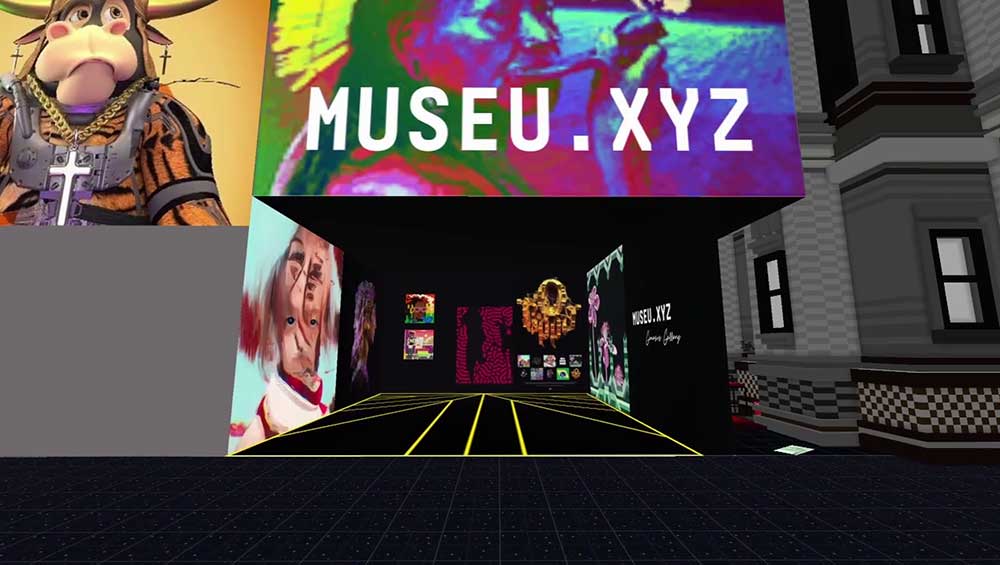
The entrance of the museu.xyz in the metaverse Voxels
by ANA BEATRIZ DUARTE
They come from very different backgrounds but have one thing in common: art. Teaming up during the pandemic lockdown, Marlus Araujo and Ana Cunha made the old and the new join forces: a centuries-old institution in a new space, the metaverse. The museu.xyz, founded last year, is the first Brazilian museum native to the metaverse. Its aim is to go further and build a bridge between the traditional and new art worlds, which one day may be indistinguishable from each other, just as real life and the virtual world were in Neal Stephenson’s 1992 sci-fi novel Snow Crash, in which the American writer coined the word metaverse.
Museu.xyz represents Araujo and Cunha’s desire to expand access and visibility for digital artists in Brazil. Araujo considers this sense of collectiveness to be a Brazilian trait. The website provides entrance to what the pair have called District.xyz, a neighbourhood of galleries of NFTs. In one, a discriminatory speech given by Brazil’s minister for the economy appears to be spoken by the animated head of the republic, the Efígie da República, depicted on an old 1 real note. Up a flight of stairs is a non-fungible token (NFT) by the Brazilian artist Shima, one of the museum’s meta-architects: on a black background, the words Só a cópia salva (Only the copy can save) are printed in white capital letters.
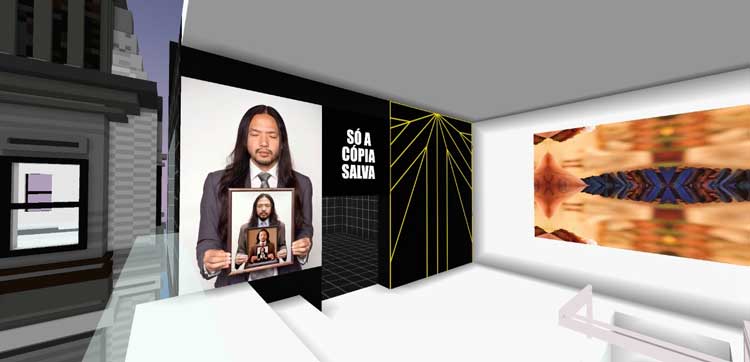
Só a cópia salva” (Only the copy can save), a work-NFT by Shima.
Outside the galleries, as well as the works on the “walls”, everything is comprised of NFTs, from the buildings to the gardens to the small pets hopping among the trees, including a small yellow bird on Marlus’s shoulder, which is a character from a game he designed. The atmosphere of this video game-like universe seems like a revival of the democratic euphoria that accompanied Web 1.0, the earliest version of the internet.
The following is an edited extract from an interview with museu.xyz’s cultural manager, Ana Cunha, and its director, Marlus Araujo.
Ana Beatriz Duarte: How did the museum project come about?
Ana Cunha: I am a cultural producer, coming from the area of education and culture. I also worked for a long time in institutions. There, I started to think that the linear format of cultural management was broken. I realised I needed to do more research on it. I enrolled for a master’s degree in creative media at the school of communication at the UFRJ (Federal University of Rio de Janeiro). It was there that I met Marlus, in 2019.
Marlus Araujo: My background is in design, but I worked with websites even before starting college. Since I first got a computer, I’ve become a bit of a hacker. I started working with interactive installations for museums, festivals and events. Various projects related to the Olympics [Brazil hosted the 2016 Summer Games]. When most of them disappeared, I virtualised my work again, with web and applications. I learned about the master’s degree from someone I met at Rio de Janeiro’s science museum, the Museum of Tomorrow.
I met Ana and others there. Then the pandemic came and, while everyone was confined at home, we were planning new projects. It was very productive. Ana and I started to exchange ideas about interactive platforms, and we began using the word metaverse long before it became popular. We used to say that everything was metaverse: 2D metaverses, videoconferencing, which is Zoom, Google Meet … We started to map them out.
At the time, I was already releasing some of my artwork as NFTs, selling them with cryptocurrency. My first sale was a dance video that was going to be displayed on a wall in a disco in the metaverse. NFT guarantees the authenticity and ownership of these items on the internet. It’s a traceable image: you can see its origin. But I didn’t understand why we were going down this scarcity path. But with the metaverse, I finally did: that image was going to be somewhere.
ABD: Was that your eureka moment?
MA: Exactly. First, I understood the reason for the NFTs. It’s like in a game: in Minecraft, you win items, such as a magic sword, and you can trade them with other players. The logic of NFTs is the same. Items are all rare. It doesn’t matter if it’s a work of art or a collectible item. The confusion arises because NFTs and digital art are public, just like when you are a collector and you donate your work to a museum.
I think these are the advantages of digital art: it can be in the creator’s gallery and on all NFT platforms. And you can sell it using blockchain, but the work will always carry the creator’s name. In addition, authors receive royalties from secondary market sales. This is not just in the art market. Metaverse outfits and land are NFTs too.
When I started with NFTs, I got really interested in the metaverse. I think that’s what the real metaverse is – a space that looks like the real world because it’s finite and persistent. It’s not a game that starts over every time I log in. Things are changing all the time there. You have random visitors, just like in the real world. It is a collective living construction. As in Snow Crash, the book that began the idea of the metaverse, it is a world created by people. It is not a small town created by some company where we only enter as users.
The museum came about when I bought my first real estate [in the metaverse]. At the time, I was very involved with the Brazilian community that was entering the world of NFTs. Ottis, who is now our architect at the museum, saw our movement and started teaching us about the building process. I had made a half-blind investment. My main intention was to be part of it and understand what it was. Once Ottis taught me about the building process, I understood that it was worth it. I’ve worked my whole life with the website and with exhibitions. I know how much a platform costs, and how much it costs to make a website, for instance. When I saw the resources available to create a 3D space on the internet, I thought it was revolutionary. And you can still allow other people to build or even make it public. It is not only those who have money who can have access.
The first space I created was a floating gallery with my NFTs, without walls. I thought that was too special to be an individual thing. When, during my master’s degree, an opportunity arose for the UFRJ Knowledge Festival, we came up with the idea for the Metaversidade exhibition [the museu.xyz’s first exhibition]. The museum arises from the desire not to do just an ephemeral thing in the metaverse, but to be the starting point there to keep the memory of everything that is happening.
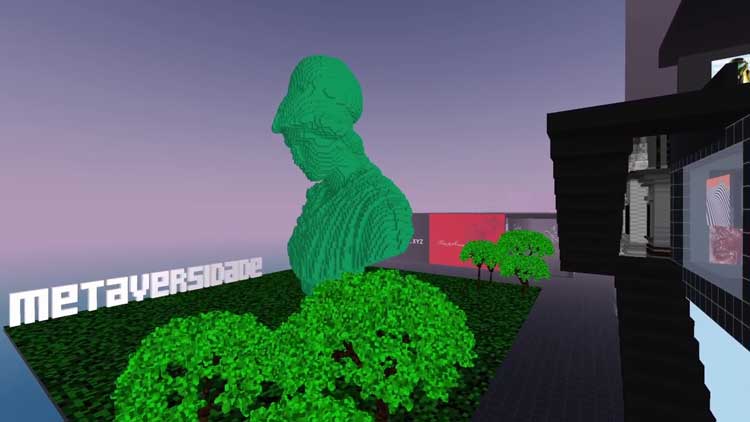
The entrance to the exhibition Metaversidade inside the museu.xyz
AC: At the museum, we have a comprehensive view of artistic and cultural expressions on the internet, in the metaverse, and on the Web 3.0. In Metaversidade, we surveyed not only museums but also concerts. We brought together initiatives from different fields and platforms, such as the guided tour of the Osgemeos: Segredos exhibition in 3D at the Pinacoteca art museum in São Paulo and the [street band] Carnival of Monobloco in the video game GTA, which took more than 2 million people to the electric trio [a truck-stage for performances typical of carnival in Brazil] in the game. These were the first Brazilian initiatives motivated by the pandemic and by the desire to transfer the activities that used to take place in the physical world. Our idea was to map different platforms and initiatives in different artistic languages. This was our kicking-off point. We conceived this collective space, a space for construction, a museum, as a centre of culture and art, and a centre for research, collaboration and creation.
MA: After Metaversidade, we had the CryptoRastas exhibition, the collection of NFTs of Digitaldubs, a music producer in Rio who is very connected to the international reggae community. Fabio Ema, who is from the first generation of graffiti artists in Rio, and perhaps in Brazil, and had worked with [reggae/rock band] O Rappa, saw me putting together the CryptoRastas exhibition and changed his life plans. He said: “If I have a land in the metaverse, I will live in it.” This showed that I was on the right path. Today, he is one of the greatest meta-architects in the world.
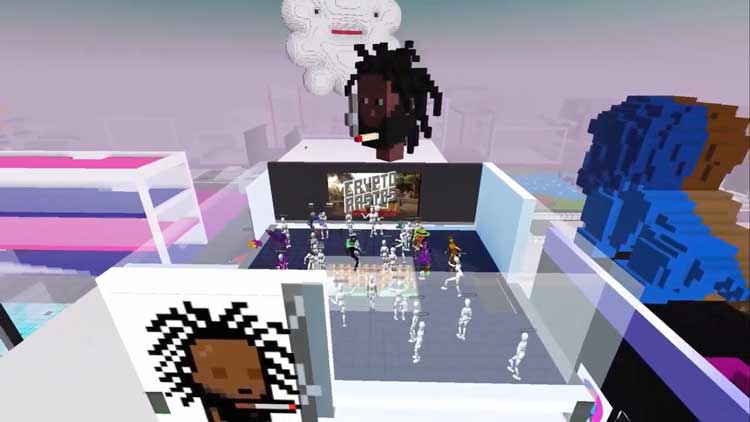
Opening party for the Cryptorastas exhibition.
ABD: Are there similar initiatives in other countries? And where is Brazil in the metaverse?
MA: I don’t know of another project like museu.xyz’s. But there are several interesting projects. The most relevant project in Brazil in the metaverse, in addition to our museum, is the Pupila Dilatada festival, which is very connected to the community of crypto artists. I think that, in Brazil, we want to do collective things.
AC: Internationally, there are examples of museums in the metaverse and a debate on NFTs far ahead of ours in Brazil. They really see digital art as a constituent of the art market. These are large, well-organised institutions from the physical world that see the metaverse as a natural path for them. But as a persistent project, I think our museum is the only example.
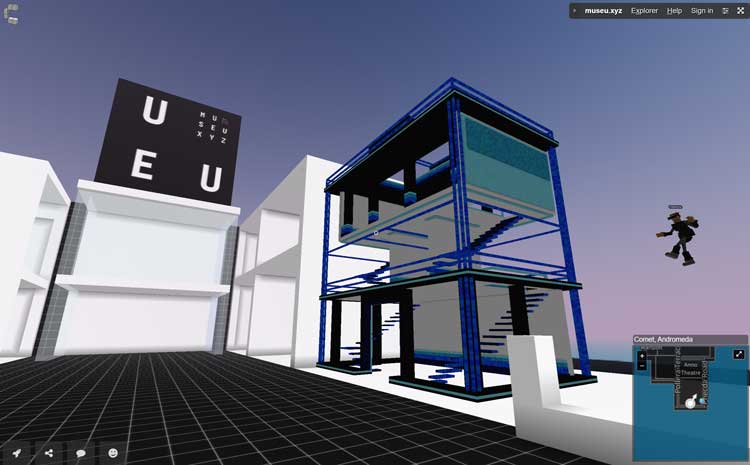
The construction of the museum’s Distrito.xyz, where who your neighbours are matters.
ABD: Persistent, in this case, means continuous, which is not a narrative?
MA: Persistence is synchronicity. It is this relationship of permanence and impermanence of things. Everything is being transformed all the time.
AC: There is a funny story about this. I was conducting a guided tour of the museum and we saw [the museum’s meta-architect] Fabio Ema. I said to the students: “See? Fabio Ema really lives in the metaverse.” It’s like when you go for a walk and accidentally bump into someone you know.
ABD: The metaverse is about chance, serendipity? The logic of the street other than the one of Windows.
AC: In Snow Crash, the character’s trajectory takes place between the physical and the virtual worlds. He rides a motorcycle in the metaverse; he travels on a boat in the physical world. At some point, you no longer want to know if he’s on one side or the other. He proposes a total integration between the two.
MA: The cool thing about the land-based metaverse, in this persistent world, is that, although it’s a world that persists, you don’t have much control over it. These accidents, these encounters happen. We are still learning to be in it. For example, a friend of mine said she couldn’t find the stairs and ended up in another gallery. In that exhibition, you had to fly to see the works. I understood that this issue of persistence is important, and it refers to the physical world. People create an affective bond to places. They want to go back and know where they are. From then on, we kept the museum’s official building, only making minor changes to the decor. It is important to work on this persistence and maintain certain elements so that the person does not feel he/she has entered a different world.
AC: There is also the issue of drifting. I once invited a person to the museum, but he went for a walk and took a dip in a swimming pool. The person can transit through the spaces.
MA: A lot of people think we built that whole world. Because it’s not a closed box, you go out exploring. It’s all about the concept of neighbourhood. That’s why the museum’s new project is built on the idea of the district.
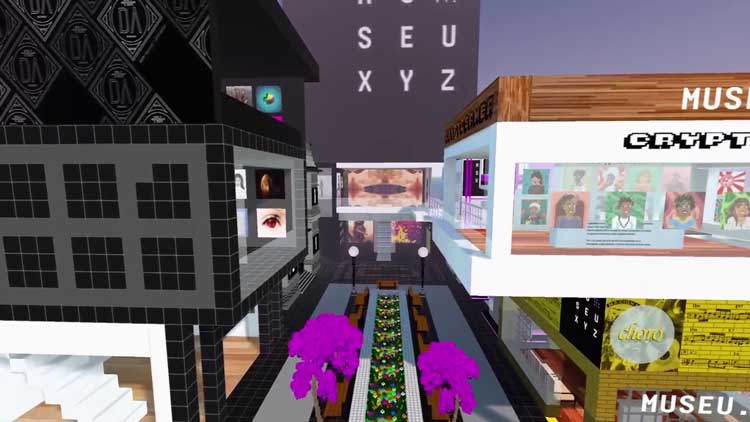
The current appearance of the museum complex.
ABD: The existence of elements from the physical world, such as stairs, are merely indicative of the many possible courses to take?
MA: This metaverse has been a place of initiation for many people who have never played video games. Anyone who is a gamer already understands the logic. We’re now in a phase where we’re recreating things from the real world. It could all be floating, psychedelic. But people who are learning to take their first steps need to find some fidelity to the real world so that they can find themselves and discover it little by little.
AC: And it can also be floating and psychedelic. In the Pupila Dilatada, for example, the idea is not to have any similarity with the outside world. It is quite an artistic, inventive project.
ABD: Are the exhibitions temporary or do they persist?
MA [showing the museum in the metaverse]: You enter through the Genesis gallery, with the first NFTs, and then comes the district, which is a series of galleries, including the Sesc space, the museum’s current project, with activities in partnership with Sesc [the social service of commerce in Rio de Janeiro]. All the members of the museum are present here: me, Shima, Fabio Ema, Ottis. For its launch, each of us invited a guest. We also created a space for Gean Guilherme, who has a social project in the Santo Amaro favela in Rio de Janeiro, Social Crypto Art; another for Fra Dao, an art collective composed of female artists of all ages; and the exhibition by Rui de Oliveira, one of the greatest illustrators in Brazil, with illustrations that were originally analog, then digitalised to be inserted in the gallery in the metaverse. We will also soon be showing an exhibition of the results of a prize awarded by the city of Belo Horizonte called Crypto Serrão, which aims to enable artists from the countryside and the poorer suburbs on the outskirts of the city to publish their first NFTs. When we make the public call, we will establish a rotation system for these spaces with the incoming resident artists.
AC: We work with the idea of resident artists and projects. The idea is for the district to be occupied by these groups. We’re getting a lot of demand from artists who want to take part. And we are thinking of making a public call, as in other museums, and holding workshops where people show their creative processes. The idea is also to encourage a discussion about the field of digital art.
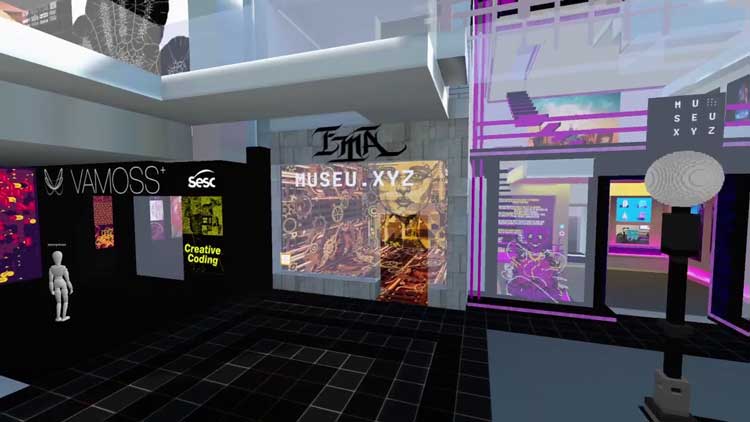
The museu.xyz has partnered with the Sesc gallery (with physical existence), in Rio de Janeiro, with an exhibition and workshops in both spaces.
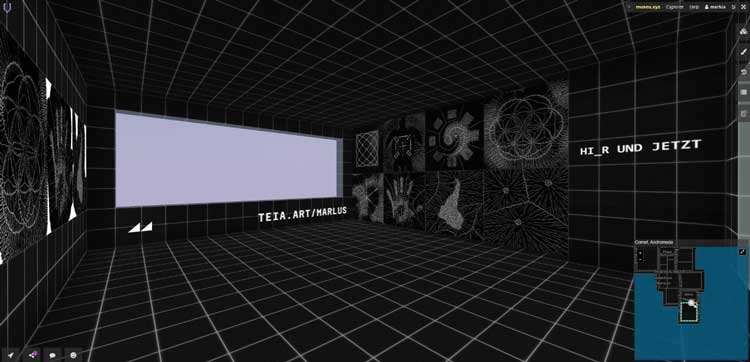
A room in the museum, with works by Marlus Araujo.
ABD: Where would these artists show their work if the museum didn’t exist?
MA: That’s the point. There was no proper space for it. The museum aims to cover this gap. These social projects are made for people who don’t have space in the metaverse.
AC: There are many galleries, but not a museum.
ABD: Can the artist create work in the metaverse, let’s say, natively, or is it transposed there?
MA: In the metaverse, we build with little blocks, like in Minecraft. But artists can also model it in software and bring it here as elements. Generally, we create outside and assemble inside. It is also possible to build using images [as structure], to place a video. And, for me, as someone who has worked all my life with exhibitions and knows the cost of a spotlight, for example, this is amazing. We can set up an exhibition in one day. So, I spent once on land, but now we have an eternal space, and we can put in as many spotlights as we want, as many images as we want.
AC: The museum itself is a creation. It is an NFT. For example, Fiac, the theatre festival of Bahia [also held at museu.xyz], was based on the concept of “sambaquis” [prehistoric shell mounds from the Brazilian seashore]. The entire exhibition building at the museum was designed around the idea of sambaquis, so the museum itself can be understood as a work of art.
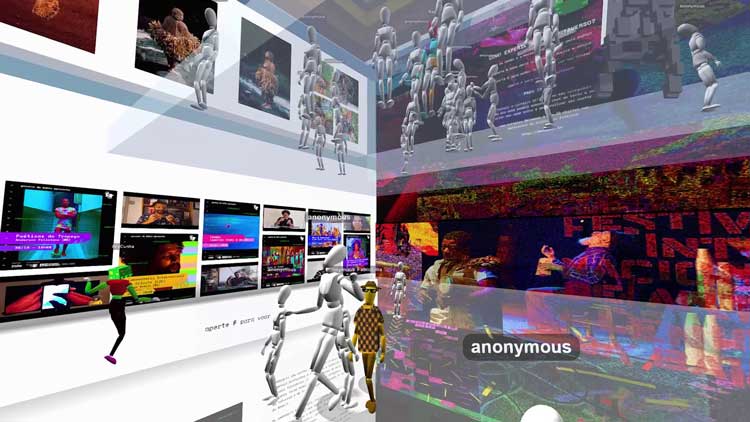
The gallery built for the theatre festival of Bahia shows innovative metaverse architecture.
ABD: What is Pindorama [the name refers to a mythical land]?
MA: Pindorama is a public document co-created by the group from the premiere of the Genesis gallery. It explains what crypto art is, with a glossary, a list of NFT platforms, prices, courses, enlightenment about ecological issues, and a catalogue of female artists. The goal was to bring accessibility to this complex topic. We wanted to ensure this knowledge was not restricted to our group.
AC: With Pindorama, we wanted to think about co-creation methodologies. We used a study by the Massachusetts Institute of Technology as a reference. It says that co-creation does not necessarily come naturally; it can be fostered. What do these collective processes imply? We observed the importance of agreements, of manifestos, to achieve a collaborative environment. People usually talk a lot about collaboration but very little about how you can collaborate.
ABD: Can the metaverse be a space for democratisation, just like the internet promised to be when it first appeared?
MA: Buying digital land is still frowned on a little. But for anyone who wants to be on the map, not in an enclosed experience, this is an interesting option because it is a relatively cheap space for all that it offers, of collective experience all over the world. I think all shows in the physical world should also be in the metaverse. This way you expand access. As different and limited as the digital experience can be, it has no geographical barriers.
AC: In that sense, the Museum of Modern Art of São Paulo project in Minecraft is very interesting. There, visitors could build new works. This is the new possibility of the metaverse: it’s not a video-guided tour. It may involve effective participation in the 3D environment. This was one of the projects we displayed during the Metaversidade exhibition.
ABD: Is that what the metaverse is, or can be, especially for the art field?
AC: I think the question of the metaverse is a very Shakespearean one: there is a debate about whether or not the metaverse exists. I think it already exists, at least as a cultural and social issue. The very fact that this discussion exists denotes the existence of a metaverse. It is a way for us to discuss these important issues, such as inclusion and democratisation. And it is also fun.
MA: I’m going to say something controversial, inspired by Hito Steyerl’s article: In Defense of the Poor Image, in which she says that the poor-quality image on the internet is an accessible image. So, in defence of NFTs and digital art, which have always been seen as less important, I say that digital art is more democratic. The fact that you don’t need to be physically present, to pass a turnstile or a museum door, makes it more democratic. I won’t discuss if land in the metaverse is expensive or not, because, in my view, people do not need to own it, if a school or a university or other institution does. The metaverse is a space for collective creation. And it does come to rescue the internet. The metaverse is rescuing the idea of a 3D site, returning to the web of the experience. The internet became very objective, with sales, direct communication and the speed of smartphone applications. Because it inherits the playfulness of games, the metaverse brings us a chance to have an internet of experiences again.
For the art field, it opens up the possibility of virtualised experiences. With forthcoming technology changes, the graphics and connection limitations are going to get more and more diffuse. Maybe even a new name will come up. But what we are already learning today in terms of collective immersion and collective creation in three-dimensional space is revolutionary and will evolve more and more.
ABD: Many people associate the metaverse with Meta, the US technology company, formerly known as Facebook. Is there one metaverse or are there many?
MA: Meta doesn’t want to lose control. But I think the metaverse is going to be very diverse and plural. What is significant to it is not the top-down approach, but this emergent process: what people are doing, what they are building. Facebook itself is looking at the community, and what is emerging out of it, so that they go into something more certain. The metaverse is being created by the people building on already existing platforms.
Click on the pictures below to enlarge